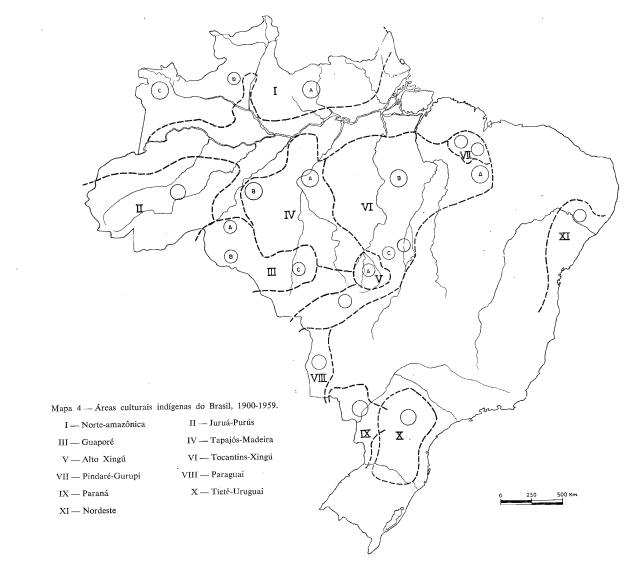Eduardo Enéas Gustavo Galvão (1921-1976) was a Brazilian anthropologist born on 25 January 1921 in Rio de Janeiro. He was one of the people responsible for consolidating anthropology in Brazil, both through his rich theoretical production on the phenomenon of acculturation and through his formulation of indigenist policies in the country.
After completing high school, Galvão began a precocious academic career in 1939 as an intern at the Anthropology Division of the National Museum in Rio de Janeiro. Soon after, in 1941, he enrolled in the course in general ethnology at the National Museum under the supervision of American anthropologist Charles Wagley (1913-1991). This not only assured him an internship as a temporary assistant naturalist – a position that became permanent at the end of the 1940s – but also started a productive friendship with Wagley that would last until Galvão’s death in 1976. As new museums were founded in Brazil in the mid-1950s, the position of naturalist became professionalized with the emergence of specialized higher education courses, closely linked to anthropological research, dealing with the study and conservation of natural, archaeological, and ethnological artifacts. In fact, Eduardo Galvão became not just Wagley’s first graduate student but the first Brazilian to receive a Ph.D. in anthropology, awarded at Columbia University in 1952.
Galvão’s doctoral dissertation was entitled The Religion of an Amazon Community: A Study in Culture Change (1952), later published in Brazil as Santos e visagens: um estudo da vida religiosa de Itá, Amazonas (1955). For this research, Galvão conducted a study of caboclo culture in Pará in the region close to the Amazon estuary, focusing on religious aspects and the influence of local Amerindian culture – caboclo is a person of mixed Indigenous and European ancestry or culture in Brazil. In his dissertation, Galvão deepened his research on acculturation, a topic he would later consolidate in his most notable texts, such as “Cultura e sistema de parentesco das tribos do Alto Rio Xingu” [Culture and Kinship System of the Upper Xingu River Tribes] (1953), in which he sought to identify the ‘uluri area’ as an Indigenous cultural zone; “Mudança cultural na região do rio Negro” [Cultural Change in the Negro River Region] (1955), referring to a delimitation and characterization of the cultural area of the Negro river in the Amazon basin; “Estudos sobre aculturação dos grupos indígenas do Brasil” [Studies on the acculturation of Indigenous groups of Brazil] (1957), his most famous text, in which the author reflects on the form in which anthropology was being produced in Brazil; and finally the publication of his proposal for “Áreas culturais indígenas do Brasil: 1900-1959” [Indigenous cultural areas of Brazil: 1900-1959] (1960).

Eduardo Galvão, “Indigenous Cultural Areas of Brazil, 1900–1959”, map. Boletim do Museu Paraense Emílio Goeldi, Belém, Brazil, Série Antropologia n. 8, p. 1-41, 1960.
The concept of ‘cultural area’ has a fundamental place in Galvão’s thought, developed in the aforementioned 1960 text. Its conceptualization and delimitation emerge from the modification of earlier interpretations that were incapable of analyzing the Brazilian case. The first step was to survey the “surviving tribes” within a given time, not too extensive to avoid making the comparative study superficial. This required reconstructing the process of cultural change through the use of historical sources. The second step was to try to determine the situation of contact among tribes in the local region, including internal intertribal contact and the varying degrees of “acculturation”, as well as external contact between so-called “tribal” societies and the national society – an example of this being the Juruá-Purus cultural area located in the lowlands of southwest Amazonia. According to him, the study of “acculturation” required a comparative analysis of Indigenous tribes. In assessing external contact, meanwhile, the categories defined by the Brazilian anthropologist Darcy Ribeiro (1922-1997) were used, combined with an indication of the advancing front of colonization (including extractive activities, cattle ranching, and crop agriculture). According to Galvão, the study of a contact situation and the cultural context is fundamental to apprehending the dynamic composition of the cultural elements in a given area. It is worth emphasizing that the schema of cultural areas elaborated by Galvão in this study is an adaptation, with alterations reflecting the author’s own criteria, of earlier area demarcations made by the U.S. anthropologists Julian Steward (1902-1972) and George Murdock (1897-1985).
Eduardo Galvão’s main research concern was thus the study of cultural change and acculturation, phenomena closely related to the concept of cultural area. Although heavily influenced by culturalist anthropologists – such as Melville Herskovits (1895-1963), Ralph Linton (1893-1953), Robert Redfield (1897-1958), and Charles Wagley – Galvão developed his studies through a critical review of how these concepts were explored by this current of U.S. anthropology. In his text “Estudos sobre a aculturação dos grupos indígenas do Brasil” [Studies on the acculturation of Indigenous groups of Brazil], for example, published in 1957, he develops a critique of the methodological inflexibility of the classical concept of acculturation. In his view, this definition treated Indigenous people merely as recipients of cultural phenomena, failing to consider cultural reaffirmation as a form of maintaining Indigenous identity. Furthermore, Galvão observed that some indigenous groups became ‘acculturated’ more easily than others. The cases analyzed in the text compare the Timbira or Karajá – who resisted assimilation – with the Tupi – who easily received cultural traits from outsiders. He hypothesized that while the former had cultures specialized to their environment and kept a distance from the caboclo culture, the Tupi possessed a culture closer to the caboclo cultural substrate. Hence, the factors of resistance or attachment to ‘tribal patterns,’ according to him, were linked to the expansion of the Brazilian sertanejo population – frontier settlers of the hinterlands of Brazil. At the same time, reflecting his close dialogue with the neo-evolutionist school, Galvão also traced the influence of geographical features on cultural phenomena and their changes. Groups living in more inhospitable places, he argued, did not ‘assimilate’ with other cultures like those with more intense experiences of contact.
The main questions of Galvão’s work gravitate around how contact occurs and the transformation of Indigenous groups into caboclos, sertanejos, and other populations making up the interior regions of Brazil. In his vast experience of fieldwork, he focused mainly on the study of the Tenetehara Indigenous people in the state of Maranhão, the indigenous groups of the Upper Xingu River, the interactions between Indigenous and non-Indigenous people in the Middle and Upper Negro River region, and the caboclo communities of Itá (a fictitious name used for Gurupá) on the Lower Amazon. In terms of his methodological and theoretical bases, he was strongly influenced by anthropologists who valued the study of large acculturative complexes – including the Brazilian ethnologists Herbert Baldus (1899-1970), born in Germany, and Egon Schaden (1913-1991), and the U.S. anthropologists Charles Wagley and Julian Steward (1902-1972) – principally when it came to ethnohistorical studies and the relationship between culture and environment. As a result, Eduardo Galvão produced his own methodology, characterized both by generalizations and by the work undertaken with different researchers, exploring the notion of culture as a system of adaptation to the constraints of history and the environment.
Although he made some fundamental theoretical contributions, Eduardo Galvão also contributed directly and indirectly to the elaboration of indigenist policies and political action in defense of Indigenous populations. He worked for the Indian Protection Service – the SPI, the governmental agency for Indigenous peoples, later substituted by the National Indigenous Peoples Foundation, the FUNAI –, and headed FUNAI’s Secção de Orientação e Assistência [Guidance and Assistance Section] in 1952. He was also a member of the Brazilian Anthropology Association (ABA), acting as president from 1963 to 1966, and participated in the elaboration of the proposal to create the Xingu Indigenous Park in Central Brazil – the first indigenous reservation created by the Brazilian government. He was actively involved in the work of the National Museum in Rio de Janeiro and the Museu Paraense Emílio Goeldi [Emílio Goeldi Museum of Pará state] (MPEG), a natural history museum and research institution in the city of Belém, in the Amazon region, where he was a researcher and head of the Anthropology Division in 1955 and director in 1961-1962, performing a fundamental role in promoting anthropology in the Brazilian scientific field. He also contributed to the consolidation of institutions like the former Museu do Índio in Rio de Janeiro (now the National Museum of Indigenous Peoples), where he worked in 1953, and the University of Brasília (UnB). In the final years of his life, he received the medal of Indigenist Merit in the ‘Science’ category (1974) and the Silver Jubilee Medal from the Brazilian Society for the Advancement of Science (1975).
Hailed by Egon Schaden (1913-1991) as “the greatest Brazilian anthropologist of our generation”, Galvão produced a scientifically rich body of work on cultural change that had a strong impact on the formulation of the Brazilian indigenist policies.
Editor’s note: In Latin America, Indigenism and indigenist policies refer to the work conducted by government officials, civil servants, and civil society organizations with Indigenous communities. In English, Eduardo co-authored two chapters on Indigenous groups of Brazil with Charles Wagley, “The Tapirapé” and “The Tenetehara” (1948), for the third volume of the Handbook of South American Indians, edited by Julian Steward; as well as the book The Tenetehara Indians of Brazil. A Culture in Transition (1949).
How to cite:
Kato, Gabriel Akira, Guilherme Olímpio Fagundes, João Pedro Gomes Balanco, and João Victor Magalhães de Almeida. 2024. Eduardo Galvão. Translated by David Rodgers. In Enciclopédia de Antropologia. São Paulo: Universidade de São Paulo, Departamento de Antropologia. http://ea.fflch.usp.br/en/author/eduardo-galvao
ISSN: 2676-038X (online)
[ PDF version ]
Gabriel Akira Kato, Guilherme Olímpio Fagundes, João Pedro Gomes Balanco and João Victor Magalhães de Almeida
Translated by David Rodgers
FARIA, Luiz de Castro, “Eduardo Galvão (1921-1976)”, Anuário Antropológico, Rio de Janeiro, v. 1, n. 1, 1977, p. 347-354
GALVÃO, Eduardo, The religion of an Amazon community: a study in culture change, Ph.D. dissertation, Faculty of Political Science, Columbia University, 1952
GALVÃO, Eduardo, “Áreas culturais indígenas do Brasil, 1900-1959”, Boletim do Museu Paraense Emílio Goeldi, Belém, n. 8, 1960
GALVÃO, Eduardo, “Cultura e sistema de parentesco das tribos do Alto Rio Xingu”, Boletim do Museu Nacional, Rio de Janeiro, n. 14, 1953
GALVÃO, Eduardo, "Estudos sobre a aculturação dos grupos indígenas do Brasil", Revista de Antropologia, São Paulo, v. 5, n. 1, 1957, p. 67-74
GALVÃO, Eduardo, Mudança cultural na região do Rio Negro, São Paulo, Editora Anhembi, 1955
GALVÃO, Eduardo, Santos e visagens: um estudo da vida religiosa de Itá, Amazonas, Rio de Janeiro, Editora Nacional, 1955
LARAIA, Roque de Barros, “Os Primórdios da Antropologia Brasileira (1900-1979)”, Revista ACENO, Cuiabá, v. 1, n. 1, 2014, p. 10-22
MAGALHÃES, Sônia, SILVEIRA, Isolda & SANTOS, Antônio (orgs.), Um encontro de antropologia: Homenagem a Eduardo Galvão, Manaus, EDUA, 2011
PACE, Richard, "O legado de Charles Wagley: uma introdução", Boletim do Museu Paraense Emílio Goeldi de Ciências Humanas, Belém, v. 9, n. 3, 2014, p. 597-615
PACE, Richard, “Os Tapirapé, Tenetehara e gurupaenses através das lentes da máquina de Charles Wagley: uma análise de conteúdo”, Boletim do Museu Paraense Emílio Goeldi de Ciências Humanas, Belém, v. 9, n. 3, 2014, p. 675-694
SILVA, Orlando Sampaio, Eduardo Galvão: índios e caboclos, São Paulo, AnnaBlume, 2007
WAGLEY, Charles & GALVÃO, Eduardo, “The Tapirapé”, In: STEWARD, Julian, Handbook of South American Indians, vol. 3, The tropical forest tribes, Washington, D.C.: Smithsonian Institution, Bureau of American Ethnology, p. 167-178, 1948
WAGLEY, Charles & GALVÃO, Eduardo, “The Tenetehara”, In: STEWARD, Julian, Handbook of South American Indians, vol. 3, The tropical forest tribes, Washington, D.C.: Smithsonian Institution, Bureau of American Ethnology, p. 137-148, 1948
WAGLEY, Charles & GALVÃO, Eduardo, The Tenetehara Indians of Brazil. A culture in transition, Nova York, Columbia University Press, 1949. Disponível em: http://www.etnolinguistica.org/biblio:wagley-galvao-1949-tenetehara

